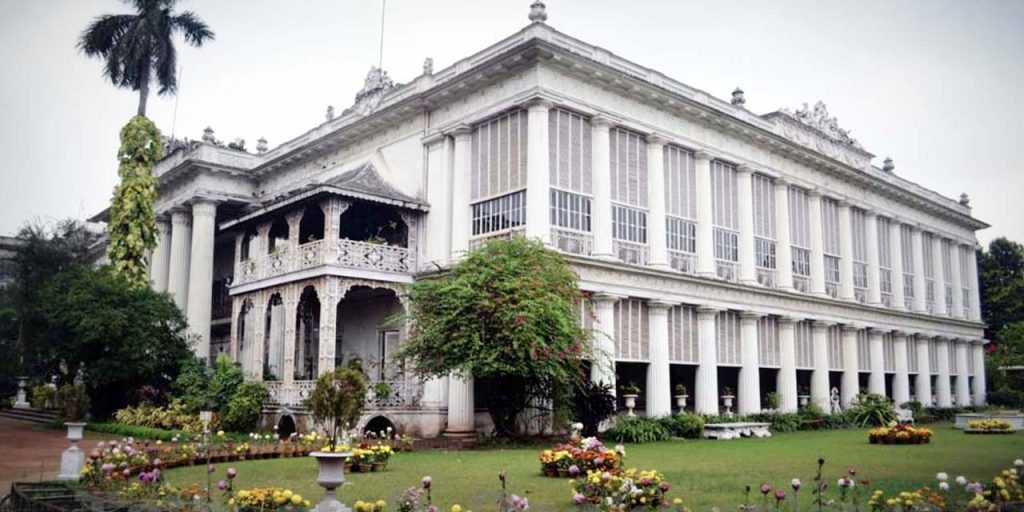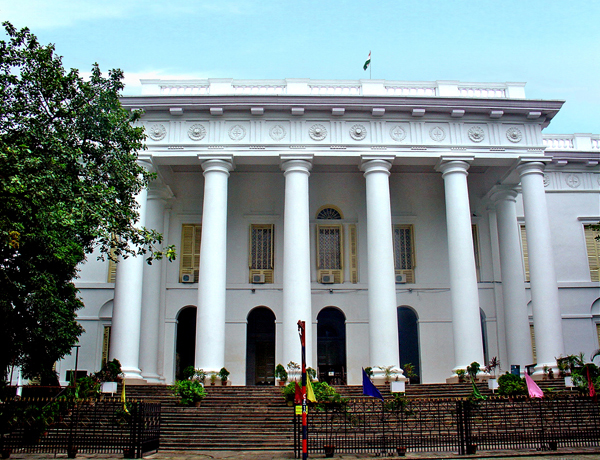A Dive into Heritage Architecture of Calcutta
Sandip Banerjee
Kolkata or Calcutta as it is originally known is certainly not a very old city, particularly when compared to many other cities of India. But with the advent of the British, it shot into prominence in a sudden spree. This city which was a swampy land with hardly any decent inhabitation gradually became the ‘Second City of the British Empire’. As the British became the political master of India, Calcutta became the Capital City. By the turn of the nineteenth century, the city not only became cosmopolitan, it became a melting pot for culture, taste and fashion. With the flourish of Bengali aristocracy and European affluence, Calcutta displayed fine array of buildings of style and architecture; it came to be known as the ‘City of Palaces’.
By the 1850s, Calcutta had developed into two areas that essentially segregated the inhabitants by colour. The British ‘White Town’ included many of the colonial buildings and municipal offices still in use today, while the ‘Black Town’ comprised of large parts of North Calcutta, including old Rajbaris and the houses of influential locals. There are two broad ways to label the colonial structures in the city- the landmark, iconic, postcard monuments and the historic, sometimes crumbling but still functional public offices. In some cases, both these labels intersect. The colonial era has gone but the hangover still persists. Even today when we survey Kolkata, we locate buildings which have withstood time, bearing testimony of the historical legacy of this city.

When we talk about Calcutta or Kolkata one of the first names that strike our minds is that of Rabindranath Tagore and ‘Jorasankho Thakurbari’. Built by Dwarakanath Tagore, this building is the ancestral house of the Tagores and is considered as the site of Bengal Renaissance as here lived Maharshi Deventranath Tagore, Poet Laureate Rabindranath Tagore and many other luminaries of the Tagore Family. The house was constructed by British architects in the Indo-European style which is evident from the façade itself. The edifice features hanging verandas, cathedral –style window and expansive aisles- all transporting us to a different era. Personal belongings of Rabindranath Tagore are all exhibited here. The house also has a painting gallery and some rooms have the walls inscribed with the great poet’s writings. Everywhere there is a display of architecture and sculpture depicting neo- classical construction.
Another shining example of neo-classical architecture that stands tall even today is the ‘Marble Palace’. Located at 46, Muktaram Babu Street, just off Central Avenue, it is one of the best preserved and most elegant houses of nineteenth century Calcutta. It is believed that as many as 125 different types of marble has been used to build the walls, floors and sculptures of this magnificent marvel; and that is from where it derives its name. Built in 1835 by Raja Rajendra Mullick this house also has a Jagganath temple within the premises. Though neo-classical in style, the open courtyards are traditionally Bengali. The house is a unique specimen of architecture with its Corinthian pillars, ornamented verandas and sloping roofs built almost in the style of Chinese pavilion. The entire mansion still emanates the flavour of ‘Baboo Culture’ of nineteenth century Bengal.

In commotion with the exquisite lifestyle of the Babus of British Calcutta we bear the story of Putul Bari or Doll House, mansion which has earned the reputation of a haunted place. Situated at the Shovabazar area of Calcutta, Putul Bari was originally a warehouse, which was eventually turned into a lavish building. This house features magnificent structures of faces of people on the top. On a moonlit night these structures appear like human beings, if viewed, suddenly. Hence the name ‘Putul Bari’ is derived. Red and pink sandstone was used for constructing this monument and the unique five-storey exterior looks like a honeycomb. Surely the building is a narration of architectural aristocracy.
One of the noted heritage buildings of Calcutta, ‘Ramdual Thakurbati’, popularly known as Latubabu- Chatubabur bari takes us back to those days when Bengal sparkled in gorgeous splendor. Situated at Beadon Street, this house harks back the neo-classical era with its engraved walls and sprawling courtyard. The site of the Puja – offering along with the image of the deity adds to the attraction of the place. This 250-year-old construction has some rare marble in the floors that still glow in appearance.

The very locale of Administration of Bengal for more than hundred and fifty years Writers’ Buildings is truly historical as it describes a running narrative of history. Designed by Thomas Lyon, the 150 metres long structure covers the entire stretch of northern fringes of the famous ‘Lal Dighi’. In the corridor of this very building the brave heart trio of Binoy, Badal, and Dinesh exchanged bullets as they attacked the very seat of British imperialism. It is like a mini township. The exterior walls are all engraved with statues of Victorian tradition. The architectural beauty lies in the spread out and in the symmetry with which the several blocks of the building are linked. It was Calcutta’s first three-storey building and was constructed to accommodate the junior clerks of the city. This is the place that stood as an epitome of British Colonial domination in Bengal or even in India.
The Old Fort William in Calcutta was built by the British East India Company in 1696. It was the main fortified settlement of the company in Bengal and served as an important military base during the eighteenth century. The fort was named after King William III of England and was one of the largest British fortifications in India. The fort was surrounded by a high brick wall and had a total of three gates. The main gate was located on the northern side. The other two gates were located on the eastern and western sides of the fort. The fort was hexagonal in shape having an area of 10 acres. The fort was also used as a prison and was the site of the infamous ‘Black Hole’ tragedy. The permission for constructing this fort was granted by the Mughal Emperor Aurangzeb. Sir Charles Eyre started the construction near the bank of the Hooghly River. In 1756, the Nawab of Bengal, Siraj-ud –Daula attacked the fort and temporarily conquered the city of Calcutta. This led the British to build a new fort in the Maidan.

The building that captivates everyone’s imagination as one proceeds from North to South of Calcutta through the Maidan area, is the Victoria Memorial. It is not just an architectural specimen; it is an emotion. Its sprawling lawn and garden has been the very centre of pleasant moments of exchanging emotions of so many over the years. This building was conceived by Lord Curzon as a fitting memoir to Queen Victoria after her death in 1901.The construction work was entrusted to Martin Burn and Company of Calcutta. The marble was quarried at Makrana in the then princely state of Jodhpur, while the statuary on the porches and the central dome was executed in Italy. The Queen’s grandson, the Prince of Wales, later to be King George V laid the foundation stone on January 4, 1906 but only on December 28, 1921 was the memorial opened to the public. An institution of national importance since the Act of 1935, the Memorial houses remarkable collection of manuscripts, paintings, sculptures, maps, coins and artifacts which are memorabilia of the Raj. In designing of the building, Sir William Emerson adopted an Italian Renaissance style with an oriental touch. The entire structure shines in splendor of statues and paintings, particularly which showcases Queen Victoria in different phases of her reign.

There are so many other magnificent edifices in Calcutta which are not just famous for their architecture but also for their association with the social, cultural and political events of this great city. One such example is certainly the Belvedere House which once was the residence of the Governor of Bengal and now houses the National Library. It is in the grounds of this Estate that the famous duel between Warren Hastings and Philip Francis was fought. It is believed that this house was gifted to Warren Hastings by Mir Zafar.
The Town Hall is another edifice which has witnessed many important meetings and events that took place in Calcutta. It is here that one of our greatest philosophers and monks Swami Vivekananda was offered a public felicitation on his return from America. Built in Doric style of architecture in1814 this two storey structure was used as a venue for balls, concerts, receptions and public meetings. The present ‘Raj Bhavan’ where the Governor of West Bengal resides is a Baroque-Neoclassical type architecture inspired by the Kedleston Hall in Derbyshire. The uniqueness of this mansion lies in creating a sense of awe even without expensive stonework. There are many other buildings of this city which epitomise the great tradition of colonial architecture of this city. Many have lost their glorified existence; many stand as relics of their rich heritage. They all together unfold an era when this great city really possessed cultural and creative wealth. As long as these edifices exist, the past mingles with the present to catch us in the suspension of time.

